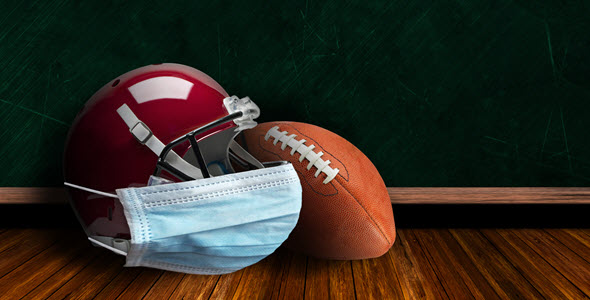By the bioMérieux Connection Editors
The cancellation of major sporting events in mid-March proved to many Americans, for the first time, how serious the COVID-19 pandemic was. The fact that major sports organizations felt the action was justified despite the effect on revenue (expected to hit $135.3 billion in 2020, pre-pandemic) signaled to the country that life as we knew it was about to change.
And change it did—sheltering-in-place, social distancing, quarantining, and wearing personal protective equipment became the new normal as the U.S. worked to flatten the curve in the spring and summer months. As the U.S. has started reopening the economy, businesses, schools, and even sports organizations are figuring out how to safely resume amidst a still-serious pandemic. This has required devising unique infection control protocols and strategies.
Infection Control Strategies Undertaken by Sports Organizations
The major sports organizations—the NBA, NFL, NHL, and MLB—have undertaken infection control techniques to get athletes back in action while minimizing the spread of COVID-19, with varying degrees of success. Each league’s strategy involves copious testing of athletes and staff with quick turnaround times, in an attempt to catch any potential asymptomatic cases.
The strategy undertaken by the NHL and NBA involves teams and staff essentially living in a “bubble”—eating, sleeping, and working within the same confined areas, isolated from family members and the outside world. This method has been effective—both leagues haven’t reported a positive case in weeks and are progressing through playoff rounds.
The MLB took a different approach. Teams still travel between cities for games (albeit less than they normally would) and live at home with their families when playing in their home cities. This strategy led to initial hiccups: the MLB had to suspend games after a week due to positive cases among players and staff. Since the initial outbreaks, the MLB has enforced stricter safety measures, with one player comparing being on the road to “almost like a prison.” While these restrictions have helped reduce the spread, new cases still pop up within the league.
“You can’t really enforce compliance when you’re not in a bubble,” Charles Cairns dean of the Drexel University College of Medicine said in a Philadelphia Enquirer article. “You bring the wild cards of exposure to travel and people who aren’t part of that system.”
The NFL is the last of the four organizations to begin games during the pandemic and is the only league whose season was not affected by the first wave of the virus—yet. The league is adopting a strategy similar to the MLB and started the season on September 10. NFL officials have had time to learn from the other organizations and their COVID-19 testing rates have been encouraging so far. Now that games have started, however, the fate of the league rests on the teams themselves.
“If the players and the teams are compliant, they’ll play. If they choose not to be compliant, then they run the risk of impacting the entire team. No one wants to be that guy,” said Dr. Larry Caplin, founder of DOCS Health, in a Q&A with CBS Sports.
The return of professional sports necessitated months of planning, a luxury that hospitals and health systems did not have. The COVID-19 pandemic came fast and hit hard, quickly overwhelming U.S. hospital capacity in cities like New York. Healthcare professionals had to quickly implement infection control strategies for a virus about which new information was constantly emerging. While the rest of the world shut down, including sports, healthcare heroes risked their own lives to care for patients. Limited testing availability and laboratory analysis capacity have proved problematic throughout the pandemic, especially in the early months—according to the CDC, many cases of COVID-19 went undetected in front-line healthcare workers.
Time to plan makes a difference, but so does expertise. In that, healthcare professionals have an advantage: decades of experience developing and perfecting infection control and prevention protocols. While the virus is novel and the COVID-19 pandemic is more serious and widespread than any recent infectious disease outbreaks, health systems have been able to build on and adapt established strategies to reduce the spread within their hospitals.
Meanwhile, professional sports organizations had to start from the ground up, learning from available information and by trial and error. The challenge is that “errors” have the potential for lasting effects on personal and public health.
The Implications of Professional Sports on Athlete Health
In the absence of a vaccine and/or widespread immunity, any return to normal activities, including sports, presents inherent risks. However, everyone has their own level of risk tolerance, which is something that each of the professional leagues took into consideration when planning their COVID-19 strategies. Athletes were able to opt-out of their respective seasons, with varying but overall minimal salary consequences.
Athletes are already more exposed to microbes compared to the general population, and thus are at a higher risk for any kind of infection and subsequent complications like myocarditis. Myocarditis in particular has received attention amidst the pandemic, as viral infections like COVID-19 are the main cause of the condition in developed countries. The wide range of symptoms from myocarditis can make it difficult to catch, but if people over-exert themselves, undetected myocarditis can lead to cardiac arrest and even death.
Myocarditis is just one of the many risks that athletes always weigh when engaging in professional sports, regardless of the threat of COVID-19. Injuries of all kinds and potential long-lasting physical effects must all be calculated into everyone’s unique risk tolerance level. With the return of professional sports, it is prudent to remember the risks that athletes face with each game and that they are now confronting an additional, more serious opponent: COVID-19.
Opinions expressed in this article are not necessarily those of bioMérieux, Inc.



